In this post I have explained the making of simple delay timers using very ordinary components like transistors, capacitors and diodes. All these circuits will produce delay ON or delay OFF time intervals at the output for a predetermined period, from a few seconds to many minutes. All the designs are fully adjustable.
Importance of Delay Timers
In many electronic circuit applications a delay of a few seconds or minutes becomes a crucial requirement for ensuring correct operation of the circuit. Without the specified delay the circuit could malfunction or even get damaged.
Let's analyze the various configurations in details.
You may also want to read about IC 555 based delay timers. Recommended for you!
Using a Single Transistor and Push Button
The first circuit diagram shows how a transistors and a few other passive components may be connected for acquiring the intended delay timing outputs.
The transistor has been provided with the usual base resistor for the current limiting functions.
A LED which is used here just indication purposes behaves like the collector load of the circuit.
A capacitor, which is the crucial part of the circuit gets the specific position in the circuit, we can see that it's been placed at the other end of the base resistor and not directly to the base of the transistor.
A push button is used to initiate the circuit.
On depressing the button momentarily, a positive voltage from the supply line enters the base resistor and switches ON the transistor and subsequently the LED.
However in the course of the above action, the capacitor also gets charged fully.
On releasing the push button, though the power to the base gets disconnected, the transistor continues to conduct with the aid of the stored energy in the capacitor which now starts discharging its stored charge via the transistor.
The LED also stays switched ON until the capacitor gets fully discharged.
Te value of the capacitor determines the time delay or for how long the transistor stays in the conducting mode.
Along with the capacitor, the value of the base resistor also plays an important role in determining the timing for which the transistor remains switched ON after the push button is released.
However the circuit using just one transistor will be able to produce time delays which may range only for a few seconds.
By adding one more transistor stage (next figure) the above time delay range can be increased significantly.
The addition of another transistor stage increases the sensitivity of the circuit, which enables the use of larger values of the timing resistor thereby enhancing the time delay range of the circuit.

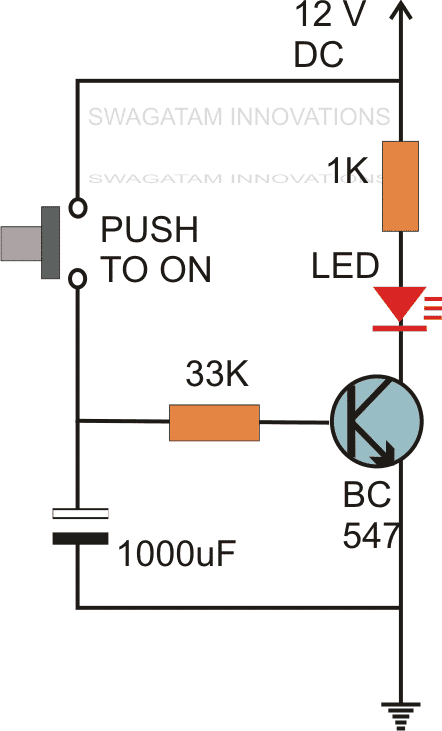
PCB Design
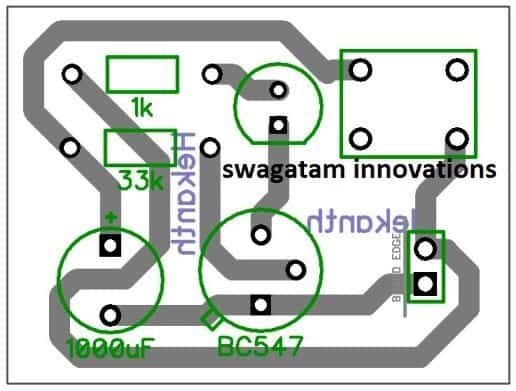
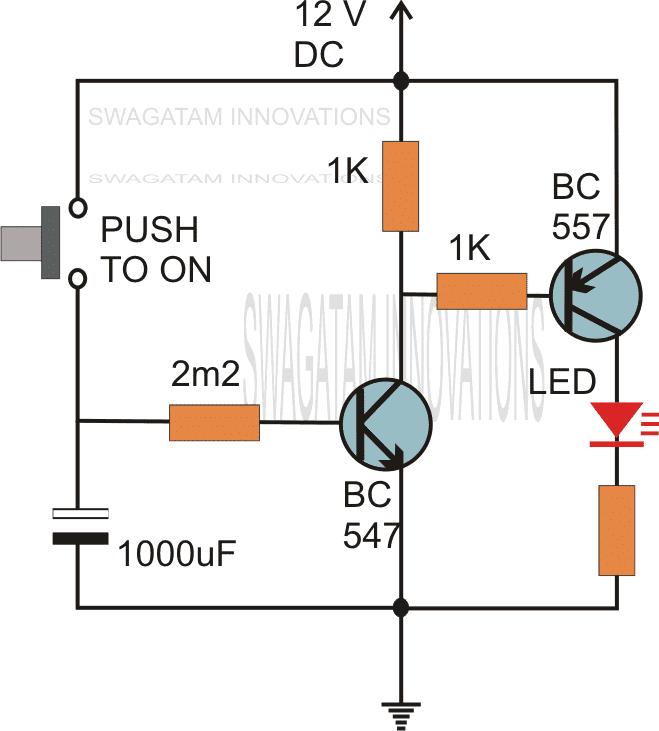
Video Demonstration
Using a Triac:
The following image shows how the above delay timer circuit may be integrated with a triac and used for toggling a mains AC operated load
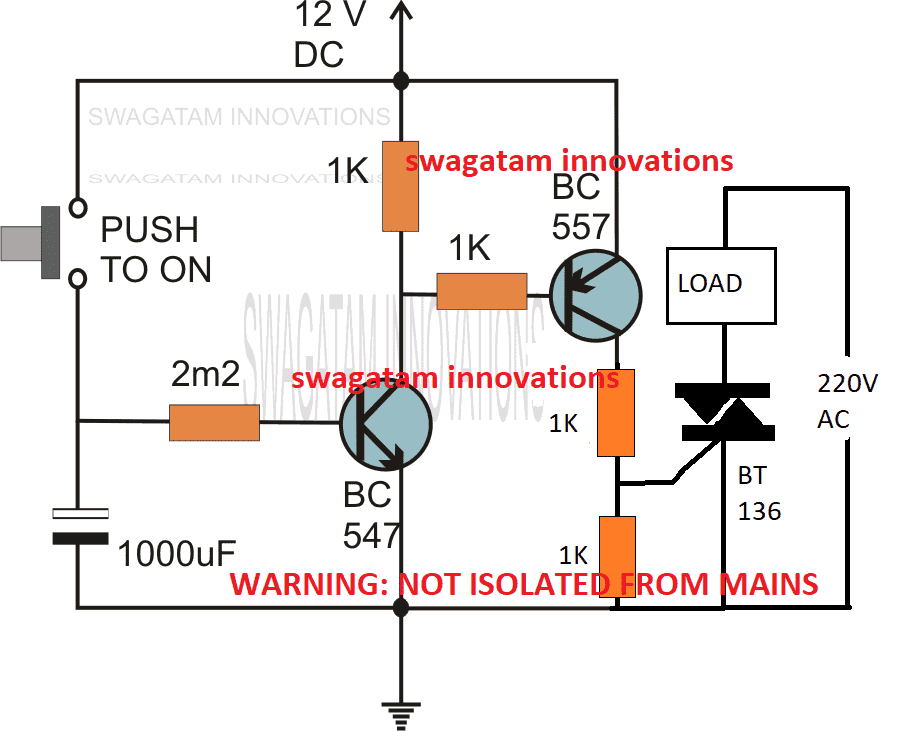
The above could be further modified with a self contained power transformerless power supply as shown below:
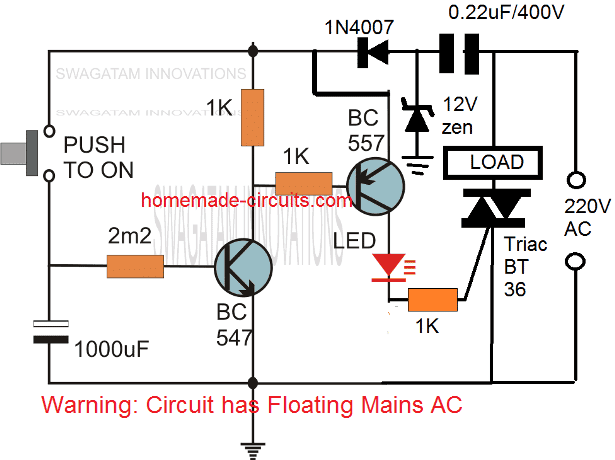
Without a Push-Button
If the above design is intended to be used without a push button, the same may be implemented as indicated in the following diagram:
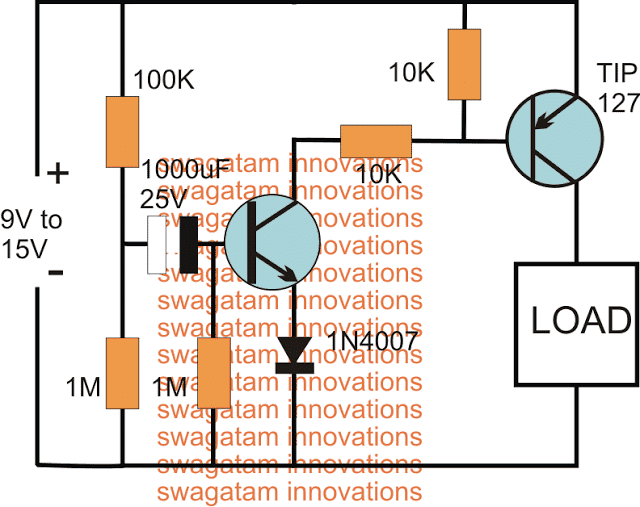
The above delay OFF effect without a push button can be further improved by using two NPN transistor, and by using the capacitor across base/ground of the left NPN
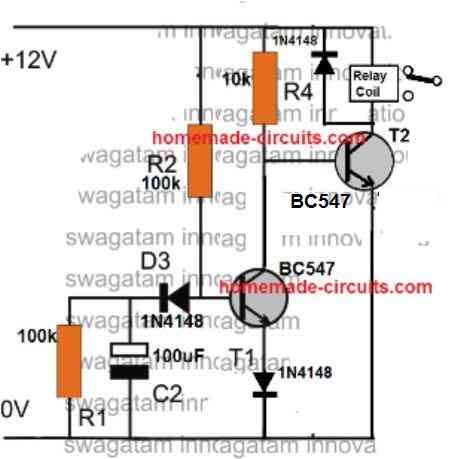
The following circuit shows how the associated push button may be rendered inactive as soon as it's pressed and while the delay timer is in the activated state.
During this time any further pressing of the push button has no impact on the timer as long as the output is active or until the timer has finished its delay operation.
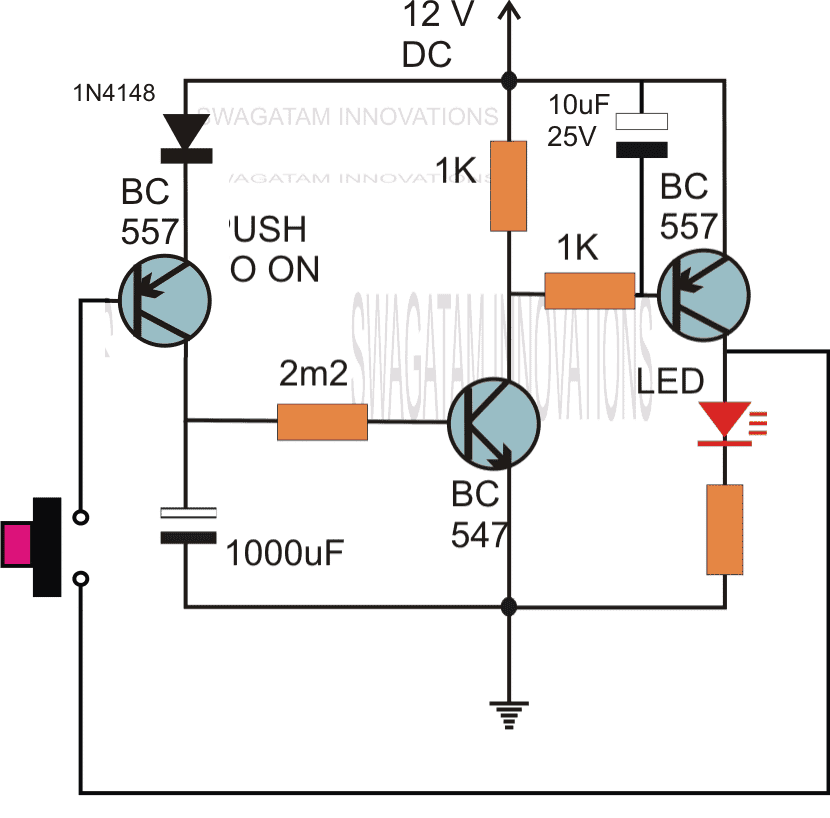
Delay from an External Trigger
Problem asked by Mr. Glen (one of the dedicated readers of this blog):
I have a situation where I have a pulse of 12V that lasts about 4 seconds (from a rotary switch being turned by a slow motor) but I only want about half a second pulse (to trigger a mechanical bell/chime).
Is there any way to take a long pulse into a circuit and send a much shorter pulse out?
The solution to the above problem is provided in the following schematic:
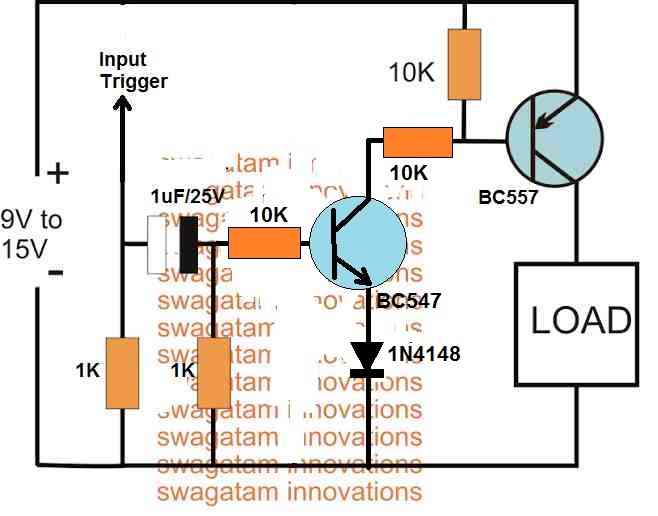
Two Step Sequential Timer
The above circuit can be modified to produce a two step sequential delay generator. This circuit was requested by one of the avid readers of this blog, Mr.Marco.
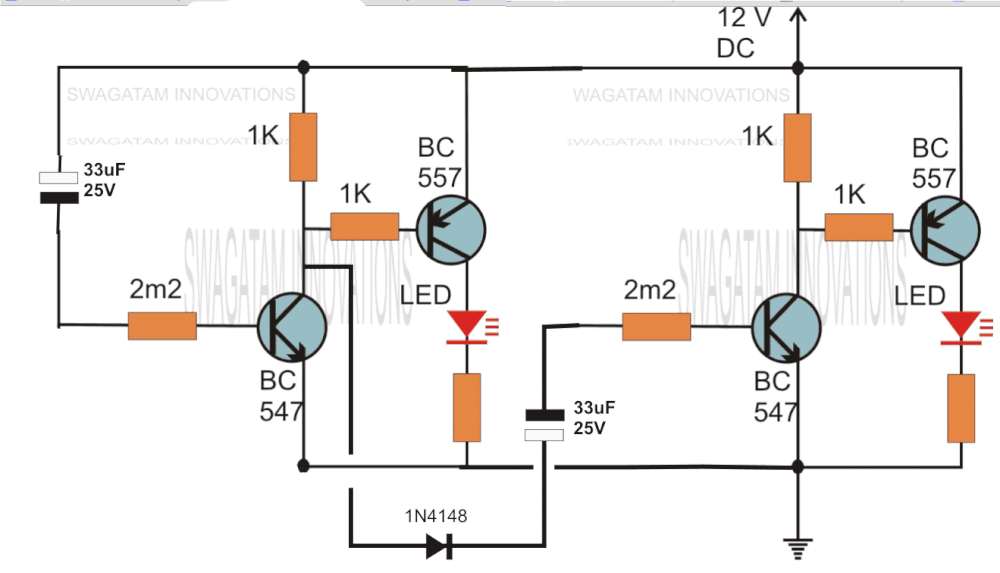
A simple delay OFF alarm circuit is shown in the following diagram.
The circuit was requested by Dmats.
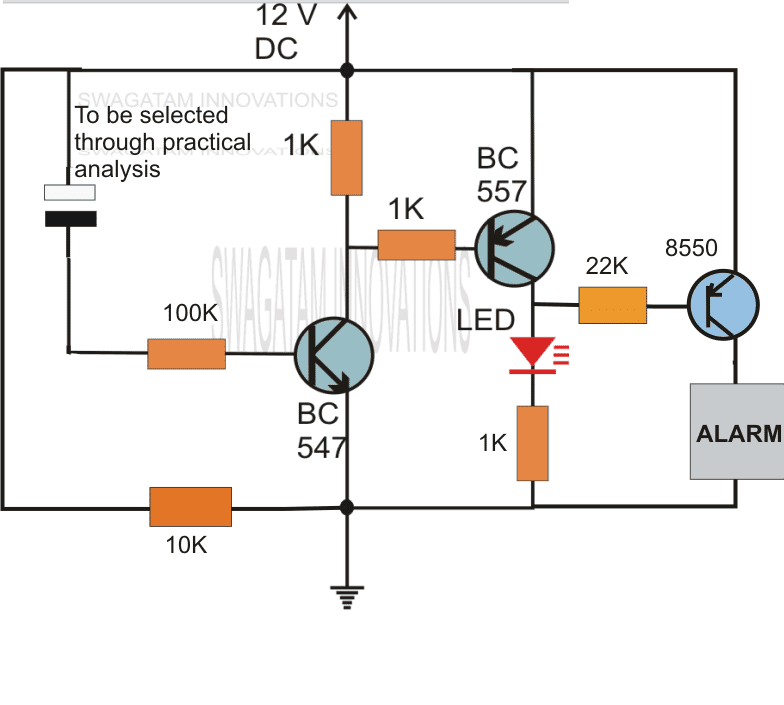
The following circuit was requested by Fastshack3
Delay Timer with Relay
"I am looking to build a circuit that would control an output relay. This would be done in 12V and the sequence will be initiated by a manual switch.
I will need an adjustable time delay (possibly displayed time) after the switch is released, then the output would go on for an adjustable time (also possibly displayed) before shutting off.
The sequence would not restart until the button was pressed and released again.
The time after the button release would be from 250 milliseconds to 5 seconds. The "on" time for the output to turn on the relay would be from 500 milliseconds to 30 seconds. Let me know if you can offer any insight. Thanks!"
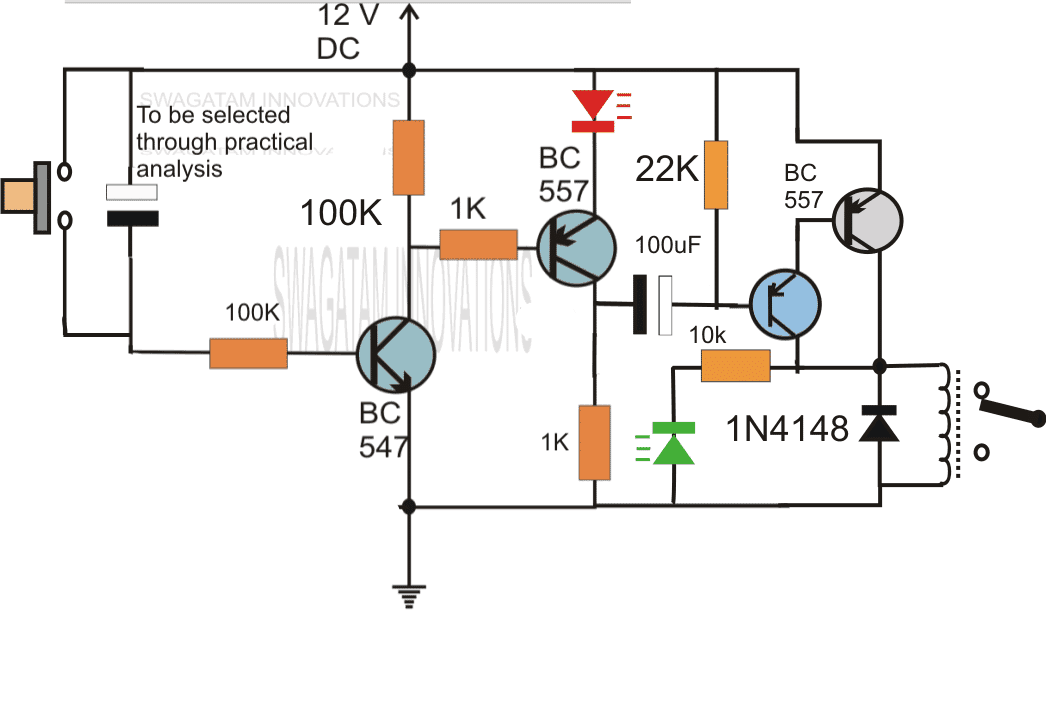
So far we have learned how to make simple delay OFF timers now let us see how we can build a simple delay ON timer circuit which allows the connected load at the output to be switched ON with some predetermined delay after power switch ON.
The explained circuit can be used for all applications which calls for an initial delay ON feature for the connected load after the mains power is switched ON.
Delay ON Timer Circuit Working Details
The shown diagram is pretty straightforward yet provides the necessary actions very impressively, moreover the delay period is variable making the set up extremely useful for the proposed applications.
The functioning can be understood with the following points:
Assuming the load which requires the delay ON action being connected across the relay contacts, when power is switched ON, the 12V DC passes via R2 but is unable to reach the base of T1 because initially, C2 acts as a short across ground.
The voltage thus passes through R2, gets dropped to relevant limits and starts charging C2.
Once C2 charges up to a level which develops a potential of 0.3 to 0.6V (+ zener voltage) at the base of T1, T1 is instantly switched ON, toggling T2, and the relay subsequently....finally the load gets switched ON too.
The above process induces the required delay for switching ON the load.
The delay period may be set by appropriately selecting the values of R2 and C2.
R1 ensures that C2 quickly discharges through it so that the circuit attains the stand by position as soon as possible.
D3 blocks the charge from reaching the base of T1.
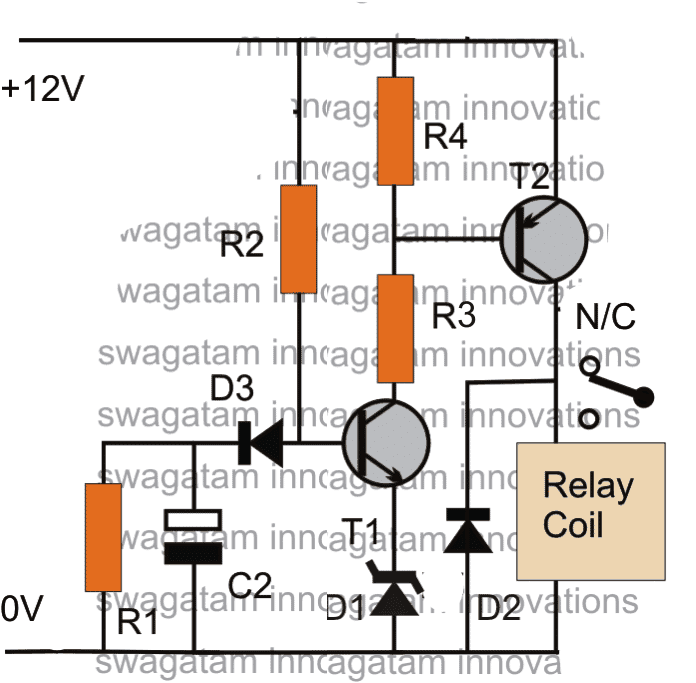
Parts List
R1 = 100K (Resistor for Discharging C2 when circuit is switched OFF))
R2 = 330K (Timing Resistor)
R3= 10K
R4 = 10K
D1 = 3V zener diode (Optional, could be replaced with a wire link)
D2 = 1N4007
D3 = 1N4148
T1 = BC547
T2 = BC557
C2 = 33uF/25V (Timing Capacitor)
Relay = SPDT, 12V/400 Ohms
PCB Design
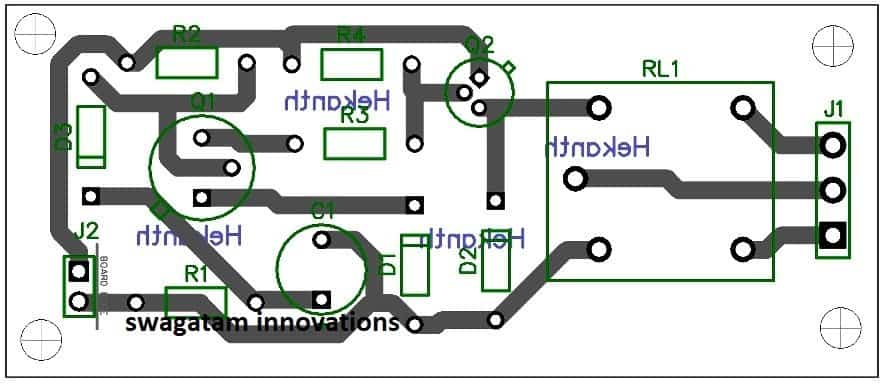
Application Note
I have explained how the above delay ON timer circuit becomes applicable for solving the following presented issue by one of the keen followers of this blog, Mr. Nishant.
Circuit Problem:
Hello Sir,
I have a 1KVA automatic voltage stabilizer.It has one defect that when it is switched on, very high voltage is outputted for about 1.5s (therefore cfls and bulb got fused frequently) after that the voltage becomes OK.
I have opened the stabilizer it consist of an auto-transformer,4 24V relay each relay connected to a separate circuit(each consisting of
10K preset,BC547,zener diode,BDX53BFP npn darlington pair transistor IC,220uF/63v capacitor,100uF/40V capacitor ,4 diodes and some resistors).
These circuits are powered by a step down transformer and output of these circuit are taken across corresponding 100uF/40V capacitor and fed to corresponding relay.What to do in order to tackle the problem.please help me.Hand drawn circuit diagram is attached.
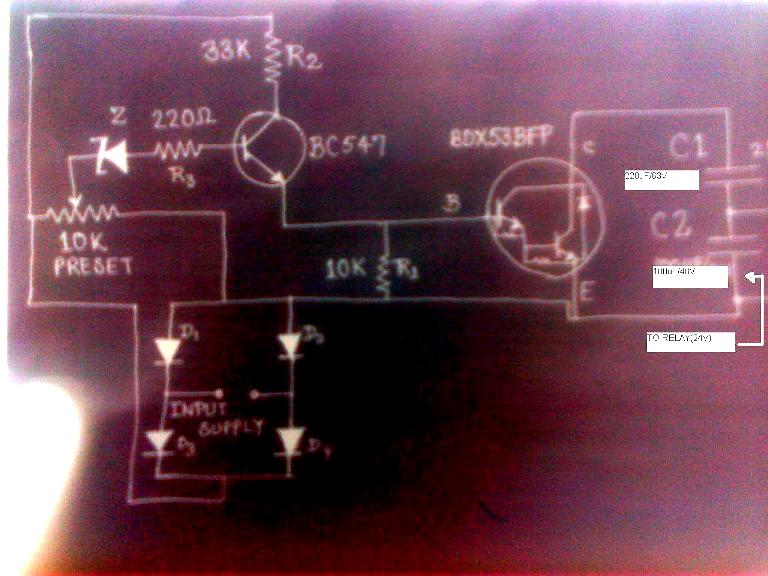
Solving the Circuit Problem
The problem in the above circuit might be due to two reasons: one of the relays is switching ON momentarily connecting the wrong contacts with the output, or one of the responsible relays is settling down with the correct voltages a little while after power switch ON.
Since there are more than one relay, tracing out the fault and correcting it can be a bit tedious......the circuit of a delay ON timer explained in the above article could be actually very effective for the discussed purpose.
The connections are rather simple.
Using a 7812 IC, the delay timer can be powered from the existing 24V supply of the stabilizer.
Next, the delay relay N/O contacts may be wired in series with the stabilizer output socket wiring.
The above wiring would instantly take care of the issues as now the output would switch after some time during power witch ONs, allowing enough time for the internal relays to settle down with the correct voltages across their output contacts.
Feedback from Mr. Bill
Hi Swagatam,
I stumbled across your page doing research on the web to make my delay more consistent.Some back ground information first.
I am a bracket drag racer and launch the car on first sight of the 3rd amber bulb as the christmas tree is coming down.
I use a transbrake switch that is depressed to lock the automatic transmission in forward and reverse at the same time.
This allows you to rev up the engine to build power for launch. When the button is released the transmission comes out of reverse and moves the car forward under high rpm.
This is like popping the clutch on a manual transmission car, anyway my car reacts to quickly and the result is a redlight, leaving to early, and you lose the race.
In dragracing your reaction time on the launch is everything and it is a game of hundreths-thousanths with the big boys, so I have put the transbrake switch on a relay and put a 1100uf cap combo across the relay to delay its release.
Because of the car electronics I don't believe there is a precise voltage charging this cap every time I activate this circuit and precision is key so I bought a power stabilizer off of Ebay that takes 8-15 volts in and gives a consistent 12volts out.
This turned my season around but i believe this circuit could be made to be more precise and to vary the delay time in an easier way rather than swap cap combos.
Also should I run a diode in front of the relay, not currently because all that is there is the on off switch- where will the current go? I am not an electrical engineer by any means but do have some knowledge from trouble shooting high end audio for many years.
Would love your thoughts- thankyou
Bill Korecky
Analyzing and Solving the Circuit
Hi Bill,
I have attached the schematic of an adjustable delay circuit, please check it out. You can use it for the mentioned purpose.
The 100K preset can used and adjusted for acquiring precise short delay periods as per your specifications.
However, please note that, the supply voltage will need to be minimum 11V, for the 12V relay to operate correctly, if this is not fulfilled then the circuit might malfunction.
Regards.
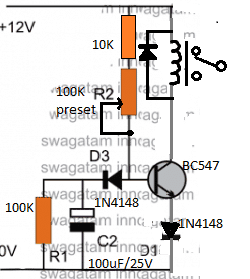
Simple 5 to 20 Minute Delay Timer
The following section discusses a simple 5 to 20 minute delay timer circuit for a specific industrial application.
The idea was requested by Mr. Jonathan.
Technical Requirements
While trying to figure out a solution to my problem on google, I came across your above posting.
I'm trying to figure out how to build a better Sous Vide controller. The main problem is that my water bath has a very high hysteresis, and when heating from colder temperatures will overshoot about 7 degrees from the temperature at which power is terminated.
It is also very well insulated, with a gap between the inner and outer vessel which makes it act like a thermos jar, because of this it takes a very long time to decline from any excess temperature. My PID controller has an SSR control output and a relay alarm output.
The alarm can be programmed as a below limit alarm with an offset from the set-point. I can use a five volt supply I already have for my circulation motor to run through the alarm relay and drive the same SSR the control output is driving.
To be on the safe side and protect the PID controller I'll add a diode to both the alarm voltage and the control voltage to prevent one output from feeding back into the other.
I'll then set the alarm to stay on until the temperature rises above the set-point minus 7 degrees. This will allow the PID tuning to be adjusted without having to account for the initial temperature ramp-up.
Because I know that last few degrees will be achieved without any power input, I'd really like a way to delay any recognition of the control signal for about five minutes after the alarm shuts off, as it will still be calling for heat.
This is the part I've yet to figure out the circuitry for. I’m thinking of a normally closed relay in series with the control output, which is held open by the alarm signal.
When the alarm signal is terminated, I need a delay on the order of five minutes before the relay returns to its ‘off’ normally closed state.
I would appreciate help with the delayed off portion of the relay circuit. I like the simplicity of the initial designs on the page, but I get the impression they wouldn’t handle anywhere near five minutes.
Thank you,
Jonathan Lundquist
The Circuit Design
The following circuit design of a simple 5 to 20 minute delay timer circuit can be suitably applied for the above specified application.
The circuit employs the IC4049 for the required NOT gates which are configured as voltage comparators.
The 5 gates in parallel form the sensing section and provides the required time delay trigger to the subsequent buffer and the relay driver stages.
The control input is acquired from the alarm output as indicated in the above description. This input becomes the switching voltage for the proposed timer circuit.
On receiving this trigger, the input of the 5 NOT gates are initially held at logic zero because the capacitor grounds the initial trigger via the 2m2 pot.
Depending upon the 2m2 setting, the capacitor starts charging up and the moment the voltage across the capacitor reaches a recognizable value, the NOT gates revert their output to logic low, which is translated as a logic high at the output of the right single NOT gate.
This instantly triggers the connected transistor and the relay for the required delay output across the relay contacts.
The 2M2 pot may be adjusted for determining the required delays.
Circuit Diagram
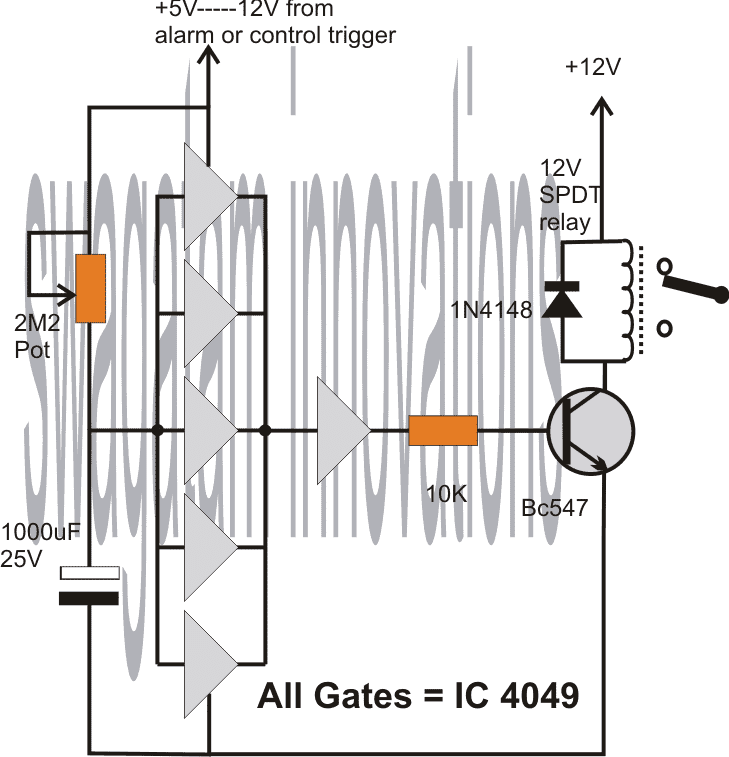

Thanks for these so simple, though efficient, working circuitries. Great Swagatam !!!
I wish to trigger the mains timer with sound (clap or any), together with the pushbutton : do I just add a microphone in parallel with the pushbutton ? Does a MOSFET improve anything ?
Thank you Ambroise, Glad you liked it!
If you want to activate the delay OFF timer with a MIC then you may have to build the design discussed in the following article:
https://www.homemade-circuits.com/simplest-sound-activated-relay-switch/
If you have a heavy DC load then you can eliminate the relay and replace the PNP transistor with a MOSFET. The referred diagram is enclosed in the above link.
Good afternoon my friend Swagatam!
Unfortunately, I severely broke my leg and spent a long time in the hospital. Therefore, I could not proceed with the manufacture of the circuit that you kindly suggested. (https://www.homemade-circuits.com/simple-touch-sensor-switch-circuit/#comment-133997)
This circuit needs thyristors, but I don’t have them and I can’t go to the store yet. But I can already sit on a chair!
But I have another request for you.
I thought about making an alarm for the open door of the refrigerator. I want to use a magnet and a reed switch as a sensor. When the door is opened, the reed switch closes and connects power to the circuit. The timer waits for 30-40 seconds, after which the beep sounds, indicating that the door is still open.
If after that the door is closed, then the reed switch opens with the help of a magnet, the power supply to the circuit is interrupted, the signal stops.
I want to power the circuit from a 1.5 volt battery. I would like to increase the voltage to 3 volts using the HH004F chip. Is it possible?
Can you suggest me such a scheme?
Respectfully,
Jorge
I am sorry to hear that friend. I hope you will recover soon.
For the fridge open delay ON buzzer circuit, you can try the following concept:
https://www.homemade-circuits.com/wp-content/uploads/2022/11/reed-switch-activated-delay-ON-timer-circuit.jpg
Let me know if you have any further doubts!
Thank you! Some questions…
What is the working principle of this scheme? What is the delay time? Regulated by R1 and C2?
When power is switched ON through the relay, the capacitor C2 is charged via R2. While C2 charges the T1 base is inhibited from the required 0.6V biasing voltage. This keeps T1 switched OFF and with T1 switched OFF T2 also remains switched OFF. After the intended delay when C2 charges fully, D3 gets reversed biased and turns off, which allows a 0.6V to develop at the base of T1 switching it ON. When T1 switches ON, T2 also switches ON, turning ON the load.
R2 and C2 are responsible for the delay timing.
There should be a 1N4148 diode in series with the emitter of T1 to balance out D3, which is accidentally not shown in the diagram.
Good afternoon my friend Swagatam!
I made a circuit from the link:https://www.homemade-circuits.com/wp-content/uploads/2022/11/reed-switch-activated-delay-ON-timer-circuit.jpg
Everything works, but only from 3 volts. If the voltage is reduced to 2.4 volts, the circuit stops working.
I changed C2 and R2 so that the signal is delayed by 30-40 seconds. I do not specifically publish the modified data of these components, since I think that a lot depends on the gain of the transistors.
There is a question: what can be done to make the circuit work from 1.5 volts?
Hi Jorge,
You can try doing a few modifications in the existing design and see if that helps.
Reduce R2 to 330K or lower and increase C2 to a higher value until the combination provides the required 30 seconds delay.
Reduce the value of R3 to 100 ohms.
Let me know if the above allows the circuit to work with 1.5 V supply.
Hi my friend Swagatam!
I changed the values of the resistor R2 to 300k, and the capacitor to 330uF. Thus, I achieved a signal delay of up to 30 seconds. But changing the value of the resistor R3 did nothing. The minimum voltage required for the circuit to work is 2.4 volts.
I solved this problem by using a mini boost module from 1.5v to 3v. Now everything works as it should.
If you are interested, you can see photo of the module and layout here:
https://www.homemade-circuits.com/wp-content/uploads/2022/12/1.5-V-timer-prototype.jpg
Respectfully,
Jorge
That is great my friend Jorge!
Reducing R3 value was supposed to make the PNP more sensitive and respond to lower base voltages.
But no problems, I am glad you could finally make the circuit to work with 1.5 V using a boost converter circuit.
Thank your for updating and keep up the good work!
Hello Sir, I want to make a Delay ON Timer Circuit operating with 5 volts. Can you please design a schematic for me?
Best regards,
Hello Ajaira, a delay ON timer circuit is given in the above article. You can use it with a 5V supply also, just make sure to change the 12V relay with a 5V one.
Thank you so much for your reply. I want to know one thing if I want to get 0.16 volt output, what will be the value of the resistor?
If your supply is 5V, then the delay ON output will be also 5V, 0.16 V cannot be obtained in this design.
Thanks for your reply. Is there any system to drop the output voltage from 5 to 0.16 or 1 volt? If yes please explain. I want to design a security module with an IR sensor for my car garage.
It can be dropped using resistors if a low current output is acceptable. For higher current you can use a buck converter to drop 5V to 1V. But I do not have this type low voltage buck converter circuit with me right now.
Thank you so much. Hope I’ll ask more questions about electronics in the future.
Sure, not a problem at all!
Good day Swagatam, thank you so much for teaching everyone so much.
Greetings from Brazil.
I’m trying to create a circuit to work with a 18650 battery between 3.3V and 4.2V that after a brief press of a push button, turn on a relay for between 30 and 60 seconds, after that turn off the relay. But it can no longer be triggered by the button, only if the circuit is turned off that it could be reset. Could you be so kind as to suggest a schematic?
Thank you so much in advance.
Thank you Macelo, you can try the following design, it looks close to what you are looking for:
https://www.homemade-circuits.com/wp-content/uploads/2014/11/transistorlongdurationtimercircuit-1.png
However I could not correctly understand what you meant by: “…..But it can no longer be triggered by the button, only if the circuit is turned off that it could be reset”
Hi, thanks for your quick reply. I meant that the circuit can only be triggered by the push button once. So after activation and consequent deactivation of the relay after the given time, the push button will no longer be able to activate the relay. And this cycle will only work again when the entire circuit is turned off and on again. It would be some kind of circuit that only works once and then has to be turned off to become operational again.
Sorry for my poor english. Thank you.
OK, got it. In that case you can try the following 555 based design:
https://www.homemade-circuits.com/wp-content/uploads/2022/11/555-monostable-with-relay-and-SCR-latch.jpg
However make sure to use a CMOS version of the 555, such as a 7555 IC so that it can work optimally right from 3 V onward.
Thanks Swagatam, I will test your circuit. All the best.
No problem, wish you all the best!
Hi Swagatam,
I tested the circuit you indicated above.
I did a simulation in Multisim, it happens that the SCR, after pressing the button, leaves the trigger in low voltage. I think it should just give a pulse on low, to trigger the 555 and then lock on high so that the button only works on the first press. In this way, the circuit is permanently activated, as if the button was always pressed. Do you have any suggestions? Thank you again.
Hi Marcelo,
Even if pin#2 is permanently grounded by the SCR, the output at pin#3 will produce only a momentary delay pulse.
If you don’t want pin#2 to be permanently grounded, you can put a 0.22uF capacitor between pin#2 and the SCR anode.
Also remember to put a 10K resistor between the positive supply line and the pin#2 of the IC.
IT WORKED! Thank you again. Your work and your promptness are exemplary.
Great! Glad it worked!
Is it possible to create a delay circuit that trips if the delay is very short, but does not trip if the delay is long? For instance, if the delay is anything less than 2/10ths of a second, it trips. But if the delay is any longer, it doesn’t.
Sorry, it looks difficult, not sure how this can be implemented practically.
Good day Swagatam,
Thank you for your prompt response (impressive!) and yes, the circuit works well.
Best,
Andre
No problem Andre! Glad the circuit worked!
Good day Swagatam,
Thank you for readily sharing your expertise, I appreciate you!
We are having many power cuts due to load shedding.
When the power comes back there is often damage due to voltage spikes and fluctuations.
I would like to switch my mains power on 10 seconds after the mains power comes back to ensure that the voltage has settled down, stabilized. (Yes, it can take this long here!)
I want a delay circuit that does not need to be energized by a switch, I want the delay to start automatically when the mains power comes back.
I only need the delay circuit, the mains switching part is taken care of already.
I would appreciate you kind assistance, my efforts so far with 555 timers has not worked reliably.
Andre Jordaan
Hello Andre,
You can try implementing the following delay ON circuit concept:
https://www.homemade-circuits.com/wp-content/uploads/2021/03/double-delay-circuit-compressed.jpg
Let me know if you have any further doubts or questions?
Show me the name of the
component that can be used to make 4 minutes delay 4minutes delay
You can try the following design:
Adjustable Timer Circuit Using IC 555
Hi!
I’m a beginner electronics enthusiast. been trying to build a blinking LED Circuit with a Relay and a capacitor. The capacitor is supposed to introduce a time delay so the LED could blink but it doesn’t seem to be working so. I am terribly confused. Please help! ????
Hi,
why would you need a relay for blinking an LED? You can simply use a transistor/capacitor circuit to blink an LED?
Hi Swagatam, thanks for sharing your knowledge.
I wonder if does exist simple one component delay timer.
I need to delay 12V DC rail for 7-15s. It may be fixed, preferably adjustable.
I have seen various schematics for popular IC 555 timer – is it possible to do it simple with one component, please?
Is it possible to do it with something like resistor or capacitor?
Thanks David,
To control the supply rail delay you will need some kind of control device which could be a transistor at the least. The resistor and capacitor timing components will control this transistor for implementing the delay.
If you use only an RC, the delay will not be sharp, it will rise gradually until the full voltage is reached. Moreover the series resistor will not allow the desired high current on the supply rail. So it doesn’t appear to be a feasible option.
Hi Swagatam,
Thanks so much for your quick response. You are the best!!!
Thanks Norman, I am glad to help!
Hi Swagatam,
I have a circuit using the very small delay chip c-005. This chip works on 2-5v. If you ground its trigger, it supplies a negative output for a delayed time adjusted with a resistor. I have connected a 10k resistor between the output of the c-005 and the base of a bc807 smd transistor. I have also connected a 10k resistor from the positive voltage of 5v to the base of the bc807 transistor. This circuit has worked for me on several projects. This new circuit uses 9v so I installed an ams1117 regulator to reduce the supply to 5v for the c-005 delay chip. So, the bc807 transistor emitter has 9v and the base has 5v which can be grounded by the c-005. Grounding the base of the bc807 transistor is supposed to turn the transistor on. My problem is the transistor is always on, no matter what the output from the c-005 delay. Is the 9v on the emitter of the transistor causing the problem? Do I need to supply 9v to the base of the bc807 transistor?
Hi Norman,
yes it is due to the 9V supplied at the emitter and 5V available from the C-005 IC. Since the 5V is lower than 9V, it is unable to block the 9V from the BC807 emitter. Meaning the BC807 is always getting 5 – 9 = -4V which is sufficient to keep it switched ON all the time.
To rectify this issue, both the voltages, at BC807 emitter and at the output of the C-005 must be equal.
????????♂️Fantastic site ???? i wonder if you can help me? I am building a model rc submarine reading your site i thought placing a timer on servo controlling dive it would reset the vanes to vertical once again the delay not worked out yet but could you help? Take care stay safe and well????♂️????
Glad you liked the site! Can you please explain the specifications of the timer, if possible I will try to help!
????????♂️ thank you ???? the needs run from receiver to two servos, that dips and raises the diving vanes for settable ( secs ) to control depth of 2.4ghz antenna after which the vanes will return to horizontal level then rest ready for the next manouvre? Not being to knowledgeable with certain circuits ???? ????the smaller the better.could you make board? Thank you,if my autistic grandson had his way he’d have it fly!!????? Probably next project ????????????
I appreciate your explanation, however I am sorry, it can be difficult for me to understand the working of your system. I only need the details of the timer, how the timer needs to function? Is it a delay OFF timer or delay ON timer? How much delay period is it supposed to produce?
????????♂️Ok thank you, the power is 12v dc,the timer is off until receiver tells the timer to allow the servo to operate the pushrod for manual adjustable time ?it being manual to adjust so the rate of descent the alloted time after which the timer will return the vanes to horizontal position ready to be used to raise the sub????? taken on a challenge haha i am no captain Nemo ????♂️ i have no other means to explain ???? for my grandson i want it to be as easy as pos for his motor skills so i thank you kindly for your time and patience if it can not be done ???? take care stay safe and well ????♂️????
No problem! I guess you are looking for a delay OFF timer. I can suggest you the following design, however I won’t be able to suggest about the mechanical integrations.
In the timer circuit below, when a trigger or a pulse is sent to the base of the BC547 transistor, the pin#3 output of the IC 555 becomes high with a 12V output. This 12V output at pin#3 remains ON for a short duration of time and then it switches OFF. This short duration depends on the adjustment of the 1M pot and the value of the 1000uf capacitor. Both can be altered for getting different output delays at pin#3 of the IC. A relay can be connected across pin#3 and ground for the necessary integrations with the mechanical systems and the relevant operations.
????????♂️ wow!! thank you very much ???????? ???? .is there a board for this circuit? Thank you take care stay safe and well ????♂️????
You are most welcome, however unfortunately there is no PCB for this design, you may have to construct it over strip-board or a vero-board
????????♂️ THANK YOU SO MUCH ???? FOR ALL YOUR HELP ???? TAKE CARE STAY SAFE AND WELL ????♂️????
Hi Swagatam,
Can your time delay on circuit be adjusted for 60 sec’s delay before turning on the relay? I also need to use the circuit in a 28vdc system it looks like the transistors are capable of 28vdc. Also how critical is the 3v zener on the emitter of T1 is it fully required?
Hi Bill,
you can create a 60 second delay by suitably adjusting the values of R2/C2 components. The BC547/557 can handle upto 45V, so 28V looks fine.
3V is introduced to easily extend the delay even while R2 C2 are relatively smaller in value. With 3V zener attached the base cannot activate until the voltage across C2 has comfortably reached above 3V which takes more time, therefore the delay is longer. Without the zener the base voltage would only require 0.6V to activate which can reach much sooner across the capacitor C2.
Thanks for the quick response I may need the Zener tried using the circuit without the Zener and could not achieve slow delays. Tried different values for R2, C2 without much success will try different Zener values as well to see what happens.
Bill
You are welcome! The zener is not the crucial element, R2 and C2 are crucial, and they should definitely cause the delay time to change significantly.
I want to construct a time delay relay circuit for an amateur radio tube type amplifier, The TD relay will be used to control the delay time in turning off the cooling fan – which should be approximately 3 minutes after turning of the AC power rocker switch for the amplifier. The fan is a 120VAC, which obtains its operating voltage from a tap on the main transformer. The amplifier power is supply is wired for 230VAC. When the rocker switch is turned OFF, the power to the amplifier is OFF. However, there is STILL 230VAC being supplied to the INPUT side of the rocker switch. This is my dilemma. I still have 230 VAC available on the input side of the rocker switch. How do I supply 120VAC to keep the fan operational for 3 minutes, with only 230VAC available on the input side of the rocker switch?
We will have use a separate capacitive power supply for operating the timer circuit, with a triac. The fan will be powered through the triac. The timer circuit will get the switching voltage from the rocker switch. Once the rocker switch is turned OFF, the timer circuit will keep the fan powered ON through the charge stored inside a timing capacitor. Once the charge inside the capacitor is exhausted the timer will switch OFF the fan.
yes, the 120V to the fan must be continuously operational. If this voltage is switched OFF then I am afraid the fan will not work.
Can you provide me circuit sketch, with component values, to make this circuit? Much appreciated.
So, the fan will draw its power, continuously, from the TD circuit? That had not occurred to me. But it is quite logical.
Regards
Yes the fan must have a continuous access from the 120V source. TD will provide the switching voltage for the triac. No relay is used here.

Here’s the proposed diagram for you:
Hello sir,I’m intending on building one of your sg3525 inverter circuit but the problem is that I will need a timer circuit so that when the battery reaches around 11.5v it switches on for some seconds and eventually shuts off so that I can get an indicator of low battery before it reaches 11v and switches off the inverter. And I would like the indicator to be a buzzer . Pls sir I would be great full concerning any positive response
Hello Melvis, you can attach the following circuit with your battery:
https://www.homemade-circuits.com/wp-content/uploads/2022/07/low-battery-buzzer-indicator.jpg
You will have to adjust the 10K preset such that 741 IC output just becomes high at 11.5V battery voltage
Sir, i need to 5v delay on circuit with a 5v relay, is there a circuit diagram available
Saroop, a delay ON circuit is already given in the above article. Please see it under the heading “Delay ON Timer Circuit Working Details”
You can use 5V supply and a 5V relay in that circuit
Thank you sir, can you provide the time for delay on circuit as per the specifications of components provided in that section
Swaroop, Only R2 and C2 determine the output delay, you will have to test it practically to check how much delay you get with the specified values, and then you can adjust their values to get your own desired delay ON time.
I have a module for use as a watel level alarm. When the higher level is reached it gives an alarm, so that we can shut down the water flow (manually). The problem is that the alarm is ON Continously until the water level goes down. I need the alarm to be ON for maybe 2 minutes and then trigger OFF even when the probes are in conduction. Putting a switch in output is easiest solution, but then we have to switch ON/OFF the switch every time, which can be forgetful. Please suggest some design for this. If needed I can send a basic diagram of components used but it has a covered module which I have not broken into. The probes use AC for water level detection.
Thanks.
I can suggest a simple circuit to solve your problem but the circuit will not use an AC based probes, will this be OK for you?
Dear sir,
Recently I started reading your blog. I became regular. Nice explanations. Kudo to you.
BTW, I have a requirment. There is intermittent DC voltage available in case of a fault. Say, 12V is “on for 2 sec and off for next two secs” and the cycle repeats, till the fault is cleared. I want to use this intermittent DC voltage to switch on a relay irrespective of on/off state of the input. ie once the DC voltage starts available, the relay should get energised until this intermittent supply is totally off which will happen on clearance of fault.
Please suggest a suitable scheme. Thanks in advance.
Thank you S Lakshminarayan, your application is quite easy to implement. You can use the first circuit from top, remove the push button, connect the intermittent signal across the capacitor through a diode 1N4148, replace the LED with a relay (with a freewheeling diode connected across the coil). You will also need to replace the 1000uF capacitor with a lower value capacitor such as a 47uF/25V. Let me know if you have any further questions.
Dear Mr Majumder,
Thanks a lot for your valuable suggestion. I will try and let you know the result in a day or two.
With regards.
You are welcome S Laxminarayan, let me know if you have any problems.
Dear sir,
I have built the circuit with bd139 and found working fine. Thanks a lot.
I have one more requirement. I have a built plasma flashback astable driver with 555. The frequency is about 25 kHz with duty cycle of 59%. Output of 555 goes to small signal push pull transistors, driving a MOSFET with very low RDS. Though the circuit is working fine (good plasma arc is produced with moderate heating of MOSFET), I am having 555 failure after some time, due to fly back voltage, though the output current of 555 is limited to 100 milliampere. The entire circuit operates on 12v DC. Current is about 2A on arcing. Transformer is wound by me with ferrite cores. No snubber or fast recovery diode across primary of transformer.
Please suggest a suitable protection circuit so as to protect 555 IC from failure.
Regards.
Dear S Lakshminarayan, the problem could be happening due to the reverse voltage spikes from the flyback coil. You can try putting a few extra components around the supply pins of the IC 555, as shown in the following diagram, and see if that helps. You can additionally put a reverse 1N5402 diode across the drain/source pins of the MOSFET
Hello.
I appreciate your hard work.
I’m going to construct the following circuit.
I am going to drive a 12V relay using a 12V power supply.
If you press the button, the relay turns on after 0.5s
If you release the button, the relay will be turned off after 0.5s.
I need your help.
Thank you.
You can try the second circuit from top. You will have to disconnect the capacitor from its existing position and shift it across the base/emitter of BC547.
The 2m2 could be reduced to 100K, and the 1000uF which is now connected across base/emitter of BC547 can be reduced to 33uF/25V….the values will need to be experimented.
The LED/resistor will need to be replaced with the relay….the relay coil must have a freewheeling 1N4007 diode.
Hello.
Thank you for your help.
I want to make another request to you.
I’m using a 220v light.
I want to BLINK by installing LED on the light switch. But the light switch has only one phase out of 220v voltage.
Will it be possible?
I look forward to hearing from you.
You will need phase and neutral both for flashing the LED, only phase will not work.
it doesn’t work.
I am still trying to drive a 12V relay using a 12V power supply.
Pressing the button will illuminate the relay 0.5 seconds later
. Release the button and the relay will turn off after 0.5 seconds.
I need your help.
Try the following set up. But the time will not be exactly 0.5 second, you will have to adjust the two capacitors to get the desired timings.
Hello.
Thank you for your reply.
I will go to the office on Friday and test it and contact you again.
I hope you have a great week.
Thank you.
Sure, no problem!
Hi.
I did a test in the office.
But it still doesn’t work.
Pressing the switch also shortens the + and -.
So I removed the – associated with the switch.
Also, if you change the first 10k to 100k, it turns on after 0.5 seconds. But off works immediately.
Which circuit operates exactly 0.5 seconds on and 0.5 seconds off?
Thank you for your help.
Sorry, yes there was short circuit in the diagram, I have removed it now. However I cannot find any other easy circuit which would give you exact 0.5V second ON/OFF. You will have to experiment with this circuit only….you can try adding a 470uF right across the relay coil and see if that helps.
The following diagram is the last option I can see. You can experiment with the capacitor C for adjusting the relay ON/OFF timing:
Oh, thank you.
Press Switch -> 0.5 second delay on
Switch off -> 0.5 second delay off
What is a simple circuit?
The time doesn’t have to be accurate.
Thank you.
The transistor circuit which I gave you is the simplest one. You can try adding a 470uF across the relay coil, or try adding a 100uF directly across the base/emitter of the transistor and see that gives you the required results.
0.5s on and 0.5s off circuit?
you can use the following circuit, just press calculate
https://www.homemade-circuits.com/transistor-astable-multivibrator-amv-calculator/
Hi
I am a member of a model railway club and for signalling we use inductive sensors in the rails. The sensors are npn i.e. when the wheel of an engine passes the sensor grounds a relay coil, the other end being connected to +12v. I am looking for a circuit to delay the on time of the relay for say 1sec. with an output from the sensor going from 12v to zero to activate.
All the above use circuits use plus volts to trigger.
Hi,
You will need to do the following modifications to your NPN transistor for getting the 1 sec or more delay:
https://www.homemade-circuits.com/wp-content/uploads/2021/09/Arduino-booting-delay-circuit.jpg
For 1 sec delay the value of the capacitor could be around 100uF, however the 10K might need to be increased to 47K
Hi
This is as far as we have got, looking to hold the relay on for 0.5sec. This is by trial and error, we cannot measure the time on, what do you think.
https://www.homemade-circuits.com/wp-content/uploads/2022/05/img057.jpg
Hi, It Looks good to me,
You can use a Darlington transistor and increase the resistor value to 100K, for getting higher delays.
Thanks, I may follow up that idea.
Hello Swagatam, I am trying to design a circuit similar to an automatic nightlight. The difference being that it needs to be off when the room lights are on, then switch on for about 10 seconds only when the lights go out, then switch off fully until the room lights come back on without doing a fade out. The other requirement is the light sensor section be powered by a solar battery and not draw off of the LED batteries, or some other type of light sensor that draws a miniscule amount of current (photo transistor?) when no light is detected. I figure there will be a capacitor in the sensor section, but I can’t figure out how to charge it without the LED’s switching on, or keeping the LED’s off when the capacitor becomes fully charged and as long as the room lights are on. I was planning on using a 2N2222 NPN transistor for the switch. The lights are 8 LED’s wired in parallel. The batteries will supply 4.5 volts. I really appreciate your help on this.
Hello T.C., you can probably try the following circuit for the mentioned application: I have used IC 555 monostable since a fade out effect is not acceptable on the LEDs. R1 and R5 both can be 10K resistors.
Thank you for your reply. The circuit you have provided is very informative, but not quite what I need. The voltage requirements in the schematic is 5-12 volts. The maximum voltage available for my project is 4.5 volts, reducing to the minimum required to light the LED’s as the batteries drain. Could you please explain the function of the 2 NPN transistors in the input circuit? If I were to use the CMOS version of the 555 (to reduce voltage requirements and current draw) the solar cell should be enough to trigger it, or am I missing something here?
Yes CMOS version of IC 555 can be used which will work with 4.5 V easily. The BC547 connected with the solar cell ensures that while light is present it remains turned ON, and keeps the other BC547 transistor turned OFF. As soon as light is switched OFF, the left side BC547 associated with the solar cell turns off which turns ON the right side BC547, which in turn causes the pin#2 of the IC 555 to be grounded, initiating the timer action. Pin#3 now turns ON for sometime turning ON the TIP122 and the LEDs until the time elapses and the systems is completely switched OFF, until the external lights are turned ON again. The solar cell is enough to trigger the BC547 since it only required 0.6 V for the process.
I pretty much understand now, but still have one question. With a 10k between Vcc and the second transistor base, and a 2.2k going to ground, wouldn’t the greater negative potential prevent the second transistor from ever being able to switch on?
The BC547 requires just 0.6V base voltage to switch ON, which can be easily acquired from the shown resistor set up, it is fine according to me.
Hi!
I am currently working on a device that controls two 6VDC pumps, where the pumps are triggered with an IR sensor. The sensor will start the first pump and run for 1-2s, then with a time delay of 2-3s the second pump should start, while the first one has already stopped.
Do you have any tips how I could accomplish my goal? I was thinking of using capacitors and transistors for the time delay, but I’m not sure how I can make sure that the first pump stops before the second pump starts.
Thanks in advance!
Hi, How is the sensor supposed to start the timer, is it through a momentary pulse? And what happens after the second pump stops?
Yes, the sensor will cause a short pulse. After the second pump stops, the system should become idle and wait for a new trigger of the sensor – then the pumps should be activated again.
This device should work similar to an automatic disinfectant dispenser. I hope my description is understandable!
OK, understood, and how is the second pump triggered, is it through a second subsequent pulse from the sensor? And a 3rd pulse for resetting the circuit?
The second pump is not separatly triggered, it should just start after the first one has stopped. It would be great if there is no need for a pulse to reset the circuit, but if thats not possible then I will use a second pulse for now.
It looks difficult without a manual triggering for the second pump. However it can be perhaps accomplished using a 4017 IC along with 4069IC and a couple of transistors. The sequence will initiate through the sensor’s negative edge signal, meaning, when the sensor switches ON and OFF then the sequence will be triggered.
Hello,
Please, Can you explain how to use the rotary switch on timer to set the time interval for a semiconductor timer such as AB 700-RTC11200U1. Practical examples would be appreciated.
Thank you.
Hi, sorry I have never used the mentioned unit, so have no idea about it.
Hi Swagatam, Im working on a ac led strip my aim is to achieve the maximum efficiency..that means I want this circuit(AC strip) to work till 300v I have also designed a circuit but there is no way that i can share it with you… How can i contact you? I hope you get my mail when i post this comment… Hope you’ll reply..
Hi Manav, you can upload it to any free image hosting site online and provide the link to me here. Make sure to remove https while providing the link.
And please post it under an LED driver article, because the above article is related to timers not to LEDs.
What is the 2m2 resistance value shown in the circuits above?
2M2 = 2.2 Meg ohms
Thanks.
In the schematic where it says: “The following circuit shows how the associated push button may be rendered inactive as soon as it’s pressed and while the delay timer is in the activated state.”
Where is the load output pins?
[img]https://www.homemade-circuits.com/wp-content/uploads/2012/05/delay2Btimer2Bimproved2Bcircuit.png[/img]
The load output is between BC557 collector and ground.
In the schematic where it says: “The following circuit shows how the associated push button may be rendered inactive as soon as it’s pressed and while the delay timer is in the activated state.” How many seconds of delay we are talking about, I need about 5 seconds delay, Can a potentiometer be added somewhere to make time delay adjustments?
I don’t remember the timing that can be achieved from a 2m2 resistor and a 1000uF capacitor. You will have to confirm it practically. You can replace the 2m2 with a 2m2 pot and a series 1K resistor. If a 2m2 pot is not available you can try a 1M instead. Remember to put a 1K resistor in series with the pot.
I also have a concern about the load resistance, I got a solenoid of 9.4 ohms with a tested 1.4 amps under 12V, do you think this load can be handled by the circuit?
If the load resistance is high, then the BC557 can be replaced with TIP127 or any similar transistor.
The load resistance is low (9.4 ohms pull solenoid), I was told by a forum member at eevblog that it will overload the T3 base even when a relay is used to energize the load.
T3 refers to the BC557 next to the diode.
You can use 10K resistor for the base of BC557 if you are using a relay. If you want to use the load directly at the collector of the transistor then you will have to calculate the base resistor, although it can be also estimated through some practical experimentation..
Dear Swagatam
Appreciate you can please assist, your guidance, thanks!!!. I want to charge a capacitor e.g. 16 V, 8 F from a car alternator and discharge the capacitor into a battery bank that is separate, not connected with the alternator. I want to, after the capacitor is charged up, electronically disconnect the alternator charging circuit from the capacitor and a few seconds thereafter electronically connect a seperate discharging circuit with the capacitor, discharging the capacitor into the battery bank (battery bank and alternator not connected). It is important that at no instance the alternator capacitor charging circiut and the capacitor discharging circuit into the battery bank will not make contact, not be connected. in contact. My question how to design the electronic alternator capacitor charging on off and the electronic battery capacitor discharging on of circuits. Apologise if this is off topic. Thanks, Regards
Thank you Andre, However this seems to be totally off-topic. If possible please post it under the following article, I will try to help:
https://www.homemade-circuits.com/multiple-battery-charger-using-dump-capacitor/
I want to make a delay push circuit in which Led should stays ON as long as push again for few seconds to turn it off.
what you are asking is a flip flop circuit, not a delay circuit:
https://www.homemade-circuits.com/build-these-simple-flip-flop-circuits/
Thanks for your efforts on this page! I haven’t seen what looks like a solution to my case, but I may have missed something. If I may, additional information on the behavior and application of each of your examples would be helpful. The descriptions are rather terse.
There are many solar powered lights on the market, and many of them have a dusk-to-dawn feature using a photovoltaic cell (whether the battery charge lasts that long is another matter). What I would like is to switch off the power a configurable length of time after the circuit is activated. For example, I’d like the light to run for one hour after the photovoltaic sensor switches on. Thus, I need a timer that operates from the moment power is applied and does so using the low power from a battery.
I imagine using a relay to control the power delivered to the light(s), but the relay control requires a timer that activates the relay initially and deactivates it after the delay (or vice versa, depending on the relay). The result will be used to illuminate a chicken coop at dusk long enough for the chickens, which have very poor night vision, to make their way inside without my having to switch lights on and off at the right time.
Thanks for your help!
Sure, that is possible using a IC 4060 circuit as described in the following article:
https://www.homemade-circuits.com/how-to-make-simple-versatile-timer/
You can try the relay based circuit, with the following modifications:
Connect the output from the dawn to dusk circuit to pin#12 of the above circuit through a 1N4148 diode.
Make sure the output from the dawn to dusk circuit is high during daytime, and becomes low during dusk or in the absence of ambient light.
Alternatively you can simply connect an LDR across the positive line and the pin#12 of the above IC 4060 circuit an get the very same results.
Good day Sir,
I have the following problem, hope you can help me with the circuit. I need to get a push-button effect when apply 220v current to the circuit, and another push-button effect when I disconnect the 220v.
Thank you very much for your support.
Hi George, you can try the following concept:
https://www.homemade-circuits.com/wp-content/uploads/2011/12/set-reset-circuit.jpg
Please enlarge the image, since it is too small to see.
Really Excellent work
Congrats for this page… Swagatam
My problem is as follow, I have 5 volts and 12 volts at disposal (both are available if needed), I can use either transistor or 555 timer.
Only one push button. I Press one time the relay switch ON. I press another time: one TTL output (transistor ?) immediately advise a microcontroler, X seconds after (around 30 secs but may be less) the relay switch OFF. and so on
Any help will be fine
Thanks and Regards
Thank you Noxam, is the relay supposed to latch when the push button is pressed for the first time. Should the 30 second delay happen only after the second press??
Dear Sir,
Initial state
1) Press button relay switch ON
2) Press Button -> immediate advise MCU and relay switch OFF after 30 seconds
3) Go to initial state
Thanks alot
Yes I have understood, but what happens if the button is not pressed for the second time? does the relay stay ON permanently? When should the delay start, after the second button press or the first button press?
Yes the relay stay ON permanently, the only way to switch OFF is to press again the second time.
The delay start after the second press. May be I was not clear but there is only one push button here.
1) Press BUTTON relay switch ON forever
2) Press BUTTON -> immediate advise MCU and start delay to switch OFF relay (30 seconds)
3) 30 sec
4) Relay is OFF
5) Go to initial state
Best Regard
Thanks, I am working on it!
Great it is not an easy case
Thank you
Yes it was not easy but I managed to do it…I hope it will work.
You can find the complete design in the below shown diagram:
Pin#4 can be used for triggering the microcontroller
Great I will immediately try a prototype.
Which Components determine the 30 secs time ?
Regards
Sure!
The 100K and the 1000uF at the base of BC517 determine the delay output….but I have selected them randomly, they will need to be adjusted with trial and error.
I like your delay timer circuit without a pushbutton. I think this would be perfect for a project that I am working on. However, in order for me to utilize this design, it need to be powered by a 24 volt DC, 1 amp power source. Can this be modified to work on the above power requirements? \And if so, how?
Yes, the same circuit can be used with a 24V supply also, without any modifications.
Hi Swagatam. My old HVAC thermostat had separate switches for Auxiliary Heat and for Emergency Heat. When I bought a new brainy thermostat, it has regular heat and Aux heat, but no connection for emergency heat. The instructions say to simply wire the aux and emergency heat wires together. Well, that means that when aux heat kicks on, it runs both heat strips. So I was thinking…if I had a delay circuit between the aux and emer heat wires, set for, say, 6 minutes, then when aux heat kicks on, it would also energize the timer and not kick on emergency heat unless aux heat couldn’t raise room temperature in 6 minutes. Voltage is 24VAC. Heat strip relay coil is 24VAC 1 amp. So circuit would have 24VAC IN, and delayed (+-6 minutes) 24VAC 1 amp OUT. Timer would reset when 24VAC input went to 0 (thermostat kicked off). Can you help me? Thanks.
Hi Jim, you can try the design which is given under the heading: “Delay ON Timer Circuit Working Details”
You will have to disconnect the R2 upper end from the supply line and connect it with the supply voltage that would appear when the the AUX heater kick in.
However, the input to R2 must be DC and not AC from the AUX heater.
Thanks. The 24VAC aux voltage is only present when the Aux line gets energized by the thermostat. So are you saying I need two voltage inputs…one constant 12VDC source for R4/T2, and one switched 12VDC source for R2? Can’t I take the 24VAC from the aux line, rectify it, drop to 12VDC, and use that as my input voltage for the circuit? Why do I need two voltage sources?
Can the circuit handle 24 V or do I need to step the voltage down to 12 V?
–Jim
OK, in that case you can rectify the 24V AC to DC and feed it across the supply lines of the delay timer. For this you don’t have to change anything in the circuit, no need of disconnecting the R2. However, if 24V DC is used then the relay will also need to be a 24V. Alternatively the 24V DC could be stepped down to 12V through a 7812 IC for using with a 12V relay.
Hi sir, pls I need delay diagram with note that will work for 8 hours and off 16 hours.
Thanks sir
Hi Zuredu, you can try the first circuit from this article:
https://www.homemade-circuits.com/how-to-make-simple-programmable-timer/
use 20 nos of parallel 1uF non-polar capacitors for C1, and use 4M7 pot for P1
Pls I need either an equivalent or another transistor to replace this b1398… I found it damage in my car stereo and we can’t find it in our local store.
You can use TIP32 as a replacement
Hi, I’m looking for a simple 12v timer circuit that delays turning off a relay for about 5 seconds (easily changed if longer delay needed),
ie turn a main 12v power switch on, timer circuit/relay turns on and controls another separate event, after 5 seconds, relay turns off, but main power is still on to the timer circuit powering the other equipment. Only turning off the main power switch and starting the sequence again will it reset and allow the delay time again.
I was looking at either of the “Without a Push-Button” circuits, would either of these work as above description?
Or is there something better?
thanks in advance.
Hi, you can try the 6th circuit diagram from top. This should be able to solve your query:
https://www.homemade-circuits.com/wp-content/uploads/2021/07/delay-off-timer-compressed.jpg
R2, C2 can be adjusted for getting the intended delay
thanks, with the R100K, C100uF values shown, what would the delay be?
what values would be suitable for approx 5 sec?
thanks again
Calculating would be difficult. you will have to experiment it practically and check.
Thank you sir, but I don’t know the right platform for this, for this is very crucial for my inverter circuit. i have actually benefited from a lot of your posts, and I will appreciate it more if you put me through on this. Thanks again
Chinomso, please use the search box at the top of the page and type the required keyword for getting the relevant posts, and then you can select one of the relevant posts to ask your question.
Hello Chinomso, you have posted your question under the wrong article, the above article is about simple delay timer, so please post it under the relevant article, if possible I will try to help!
Thank you so much for this lucid lecture. Please sir I need an ON delay timer circuit diagram whereby during delaying a blinking LED will be glowing and after delaying it switches off while the ON LED starts glowing. My DC supply is 12v. I need it for my project. Thanks.
Thanks moses, what is the range of the delay time….if it is short then a transistorized circuit can be applied, if it is much longer then an IC 4060 will be required….let me know about it!
Thanks sir The delay time is 5seconds. I need the circuit diagram for that. That blinking effect of the LED marking when the delay is on is very important for the project. And again the blinking LED should stop or switch off when the delaying has stopped and the load is now activated with ON LED now glowing. Thanks.
Hi Moses, you can try the following design:
for the blinker circuit you can try the following design:
Single Transistor LED Flasher Circuit
….T2 should be BC547, it is mistakenly shown as BC557. T1 can be any other powerful transistor such as TIP122 etc. depending on the load. The actual load can be connected between the the positive line and the collector of T1
Thanks a lot sir.I hope the blinker LED will go off as soon as the load becomes activated.
yes it will go off when the delay is over, and the load is On
Thanks a lot dear,am grateful. I think there is a natural calling dimension of what you here. You will continue to increase in wisdom as you do this. God bless you richly.
No problem Moses, God bless you too!
Good day sir. I need a similar circuit you designed for me but this time an ON delay timer circuit with blinker LED that blinks for 5seconds and then continues glowing without blinking any further as soon as the load becomes activated. God bless you.
Hi Moses, did you try the previous circuit, is it working?…..the new circuit can be designed only once the previous circuit is tested and confirmed!
Is there an inexpensive way to set up a cascading digital data delay so that the original signal is delayed in several discrete stages? My proposal is to delay by hours to days an identical action taking place in another unit, followed by another identical unit with the same delay. The loads are LED lights, a small water pump, and a small fan. The application is in a series of planters where a computer turns on the PLC controlling full spectrum lights and simulates wind with a small fan and waters as necessary using a pump on a moisture control. I want the same action taking place in the other units by delay.
If these are simple logic levels, then it can be delayed using a 4017 IC, but if the data is a complex information such as a set of signals or frequency then it cannot be delayed by a simple method
Hi,
After days of research, i finally saw this article and its very interesting and helpful at the same time.
Being a mechanical engineer, i have not much knowledge about electronics. But i always fascinate how simple components does the trick and operates from simple to complex logics.
My intention is to build a tennis ball throwing machine.
My requirements are, once the machine turns left it should press the limit switch and in turn should stop the turning motor (M1) only for 2 seconds and the should start the motor again in order to crank the machine towards right(changing of dirrction will be done by mechanical crank and levers). And then same thing should happen again over the right side.
Also at the same time, the either limit switches should stop the supply to a proximity sensor installed at motor M2 only for 0.5 seconds and then the supply should start again as normal.
Supply would be 12V dc.
Kindly advise, thanks..
Hi, I will try to design the circuit soon, and post it as a new article. However it won’t be a simple design rather a complex one involving 3nos of IC 555 circuit
I truly appreciate this post. I have been looking all over for this! Thank goodness I found it on Bing. You have made my day! Thanks again
I am glad you found the post useful, thanks for your kind feedback!
Hi swagatam,
Can you please make 555 timer based ON time delay for 5min adjustable with 12v powering the circuit.
Actually many circuits i saw is delayed ON after pressing the push switch. But I need the circuit without using push switch. If powered the circuit, it should automatically start timer
As same like a stabilizer works.
Thank you ????
Hi Vamsi, do you want the timer output to switch ON after some delay? Normally the output becomes ON immediately when the switch is pressed and then switches OFF, so do want the opposite.
Hi swagatam
Yes. Exactly. I want the timer output to switch ON relay after some delay. But here I need the circuit without push button.
That means same just as like a telivision stabilizer.
If powered the circuit it should start timer and after 5min. delay then the relay should stay activated.
Thank you very much for the reply
Hi Vamsi, I think the following IC 555 circuit can work to provide the inverted delay ON output.
The diodes are optional, they can be ignored and removed…..
Sir,
Here why a 1k resistor used in between 12v and out / 547 transistor….?
And R3 1meg and C2 470uf both the components are for setting delay right sir…?
Thank you
Hi Vamsi,
The 1K provides the positive output after the delay is over.
yes R3 and C2 are for the time delay adjustments.
Hi prince of electronics mr swagatam, ever glad to hear from you. Please can you help me
to connect a two segement diplay on the the circuit of 5 to 20 minutes timer delay on?
I will be grateful for your support as usual. Thanks.
Thank you Kaluya, You can refer to the following article, it shows how to make a digital timer using a two segment display.
https://www.homemade-circuits.com/simple-digital-timer-circuit-with-2-digit-display/
Sir can you make a diagram for adjustable on and off timer. Please for saving electricity of cooler water pump.
Abhay, you can try the second concept from the following article using IC 4060:
https://www.homemade-circuits.com/how-to-make-simple-versatile-timer/
To know more about IC 4060 you an read the following article
IC 4060 Pinouts Explained
I am in need a a delay on/delay off timer. Upon input contact closure I need a 1 to 2 second delay before the timer contact closes (and stays closed) and then upon the original contact opening, a delay of 3 to 5 seconds before the timer contact opens. Thoughts on how that might be accomplished?
Thanks!
You can try the following design:
Hello Swagatam. I want you to help me with a simple diagram that has a relay without a push button. When we connect it to a 12 volt source it gives one pulse and stops working even if the circuit is not disconnected from the source.
Thank you very much.
Hello Abuesak, the solution is already given under the heading “Without using Push-button….” in the above article.
You can use the second diagram. and adjust the R2/C2 values for getting the 1 second ON time.
Dear engineers Swagatam
Please help us to get a analog circuit diagram of a Beeper.
Periode :3000 ms
– Thin beep duration 1000 ms
– Bass beep duration 2000 ms
Thank You very much for your answer.
Institute of Biophysic
March. 28.2021
Sorry Hamid, I do not have this circuit with me at this time!
Helo sir
I expect the delay circuit to energize the relay after about 5 seconds and remain on indefinitely nuntil the stabilizer is switched off again,because the stabilizer output wire passes through its 12v relay.the delay circuit having its own relay,is energized and the its relay allows the stabilizer output wire to pass through after like 5 seconds.
Patrick, I think it is just a delay ON timer circuit that you want, you can find it under the heading “Delay ON Timer Circuit Working Details”
The D1 zener can be removed and replaced with a wire link.
Adjust the values of R2/C2 appropriately for getting the 5 seconds delay